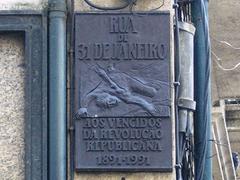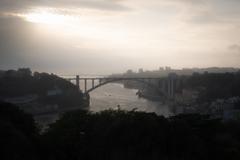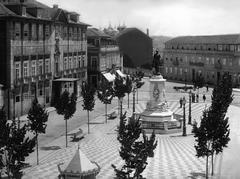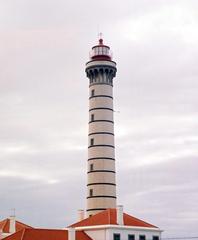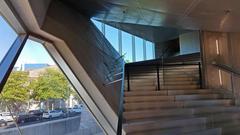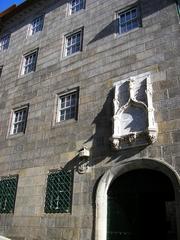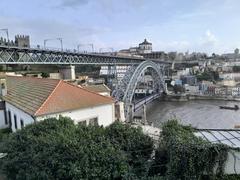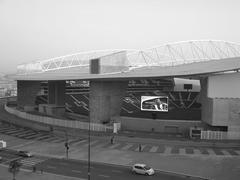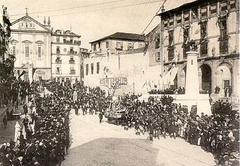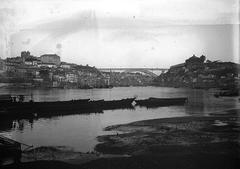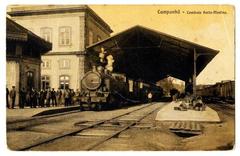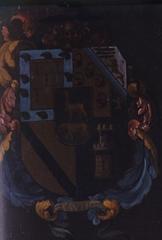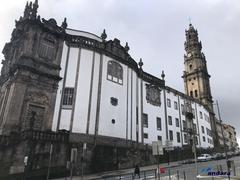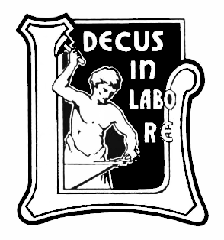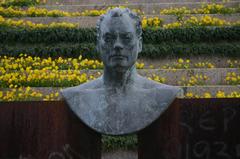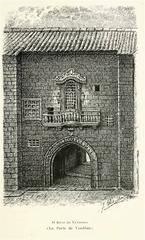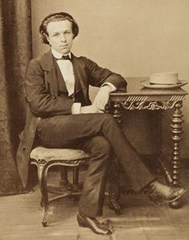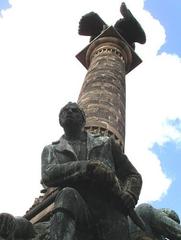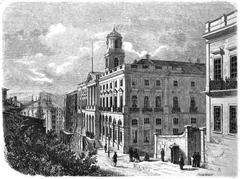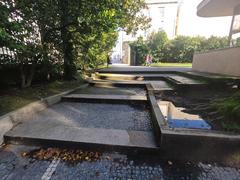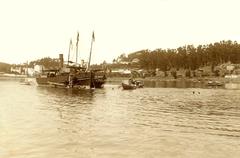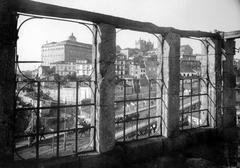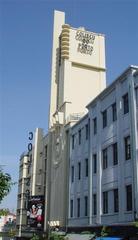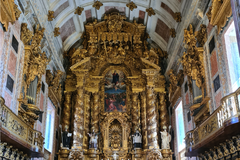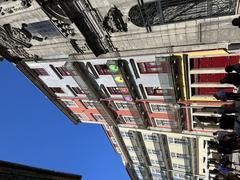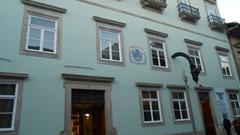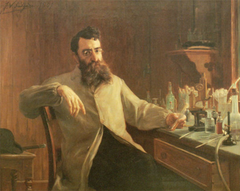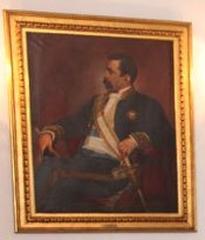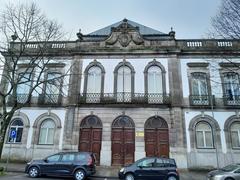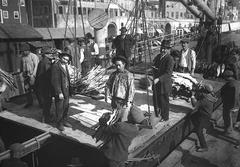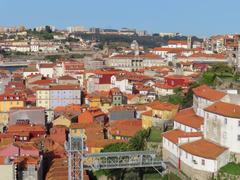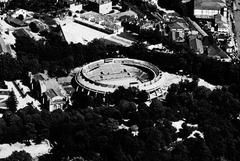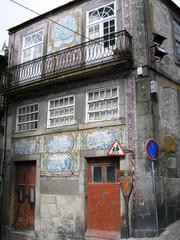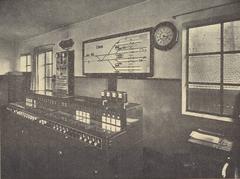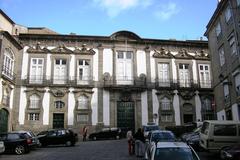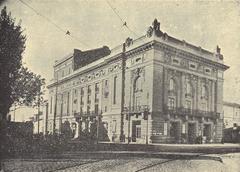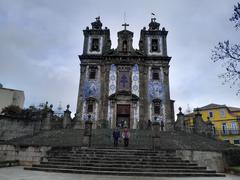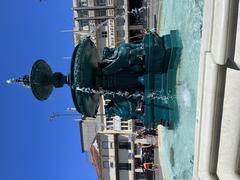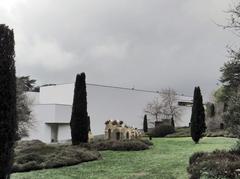
ट्रिब्यूनल दा रिलाकाओ डो पोर्टो: यात्रा का विस्तृत मार्गदर्शिका
दिनांक: 07/04/2025
परिचय
पुर्तगाल के पोर्टो शहर के ऐतिहासिक केंद्र में स्थित, ट्रिब्यूनल दा रिलाकाओ डो पोर्टो (Tribunal da Relação do Porto) पुर्तगाली न्यायपालिका के इतिहास और वास्तुशिल्प विरासत का एक महत्वपूर्ण स्थल है। 16वीं सदी के अंत से अपनी जड़ों को खंगालते हुए, यह अपीलीय न्यायालय उत्तरी पुर्तगाल के कानूनी, नागरिक और सांस्कृतिक विकास में एक महत्वपूर्ण भूमिका निभाता रहा है। आज, इसकी इमारतें—जिनमें नवशास्त्रीय पूर्व न्यायालय और जेल, और आधुनिक पलासीओ दा जस्टिसा (Palácio da Justiça) शामिल हैं—आगंतुकों को सदियों के न्याय, कला और नागरिक पहचान को जानने के लिए आमंत्रित करती हैं। यह विस्तृत मार्गदर्शिका ट्रिब्यूनल के इतिहास, वास्तुशिल्प हाइलाइट्स, आगंतुक जानकारी (घंटों, टिकटों और पहुंच सहित), और इस प्रतिष्ठित पोर्टो स्थल की यात्रा का अधिकतम लाभ उठाने के लिए सुझाव प्रदान करती है (म्यूसीओ वर्चुअल टीआरपी; पोर्टो डी’ओनरा; पुर्तगाल ऑल ओवर)।
विषय-सूची
- परिचय
- ऐतिहासिक अवलोकन
- वास्तुकला और कलात्मक विशेषताएँ
- आधुनिक समय में ट्रिब्यूनल
- यात्रा संबंधी जानकारी
- अक्सर पूछे जाने वाले प्रश्न (FAQ)
- आगंतुकों के लिए सिफ़ारिशें
- निष्कर्ष और कार्रवाई का आह्वान
- संदर्भ
ऐतिहासिक अवलोकन
उत्पत्ति और प्रारंभिक विकास
ट्रिब्यूनल दा रिलाकाओ डो पोर्टो की स्थापना 1582 में स्पेन के फिलिप द्वितीय (पुर्तगाल के फिलिप प्रथम) के शासनकाल में हुई थी, जिसका उद्देश्य ट्रांस-ओस-मोंटेस, एंट्रे डोरो ई मिन्हो और बेइरा जैसे उत्तरी क्षेत्रों के लिए एक अपीलीय न्यायालय के रूप में कार्य करना था (विकिपीडिया; पोर्टो डी’ओनरा)। मूल रूप से पोर्टो कैथेड्रल के पास कासा दा कैमारा में स्थित, अदालत को जल्द ही अपनी सुविधा की आवश्यकता हुई। 1603 में निर्माण शुरू हुआ, जिसके परिणामस्वरूप एक ऐसी संरचना बनी जो उस युग की दोहरी न्यायिक और दंडनीय जिम्मेदारियों को दर्शाते हुए अदालत और जेल दोनों के रूप में कार्य करती थी (पोर्टो डी’ओनरा)।
1752 में मूल इमारत के ढह जाने के बाद, 1765 और 1796 के बीच एक नई नवशास्त्रीय संरचना का निर्माण किया गया, जिसका निर्देशन जोआओ डी अल्माडा ई मेलो और यूजीनियो डॉस सैंटोस ई कारvalho ने किया था (रोटा पोर्टो लिबरल)। यह इमारत 20वीं सदी में भी अदालत और जेल दोनों के रूप में कार्य करती रही।
ट्रिब्यूनल का अधिकार क्षेत्र और ऐतिहासिक भूमिका
ट्रिब्यूनल दा रिलाकाओ डो पोर्टो पुर्तगाल की न्यायिक प्रणाली का एक आधारशिला था, जो उत्तरी और मध्य पुर्तगाल की निचली अदालतों से अपील सुनता था। सदियों से, इसने इस क्षेत्र में कानूनी अभ्यास को आकार देने और न्याय तक पहुंच सुनिश्चित करने में महत्वपूर्ण भूमिका निभाई (विकिपीडिया)।
पलासीओ दा जस्टिसा में स्थानांतरण
20वीं सदी के मध्य तक, मूल सुविधाएं पुरानी हो चुकी थीं। पलासीओ दा जस्टिसा का निर्माण 1958 में शुरू हुआ, जिसे राउल रॉड्रिग्स लिमा द्वारा डिजाइन किया गया था, और 1961 में इसका उद्घाटन किया गया (पुर्तगाल ऑल ओवर; म्यूसीओ वर्चुअल टीआरपी)। यह आधुनिक इमारत आज भी ट्रिब्यूनल दा रिलाकाओ डो पोर्टो, साथ ही ट्रिब्यूनल जुडिशियल दा कोमारका डो पोर्टो का घर है।
वास्तुकला और कलात्मक विशेषताएँ
पलासीओ दा जस्टिसा
पलासीओ दा जस्टिसा 20वीं सदी के मध्य की पुर्तगाली वास्तुकला का एक प्रतीक है। इसका ग्रेनाइट का मुखौटा, राजसी स्तंभ और मूर्तिकला विवरण—जिसमें लियोपोल्डो डी अल्मेडा की सात मीटर की न्याय की मूर्ति और यूजीक्लिडेस वाज़ की एक राहत शामिल है—अधिकार और सद्गुण का प्रतीक हैं (पुर्तगाल ऑल ओवर)। आंतरिक सज्जा में प्रमुख पुर्तगाली कलाकारों के 50 से अधिक कलाकृतियाँ हैं, जो कार्यक्षमता को सांस्कृतिक समृद्धि के साथ मिश्रित करती हैं (म्यूसीओ वर्चुअल टीआरपी)।
पूर्व ट्रिब्यूनल और कडेइया दा रिलाकाओ
पूर्व ट्रिब्यूनल और जेल, जो अब सेंट्रो पुर्तुगुएस डी फोटोग्राफिया (Centro Português de Fotografia) का घर है, मजबूत ग्रेनाइट निर्माण, सममित नवशास्त्रीय मुखौटे, और इसकी दोहरी भूमिका को दर्शाने वाले लेआउट को प्रदर्शित करते हैं (स्मारकों SIPA)। आंतरिक हाइलाइट्स में मुख्य सीढ़ी, संरक्षित अदालत कक्ष और वायुमंडलीय जेल कोठरी शामिल हैं।
आधुनिक समय में ट्रिब्यूनल
1974 की कार्नेशन क्रांति (Carnation Revolution) के दौरान, पलासीओ दा जस्टिसा पुर्तगाल के लोकतंत्र में संक्रमण के दौरान न्यायपालिका के लचीलेपन का प्रतीक बन गया (ट्रैवल इंटि)। ट्रिब्यूनल उत्तरी पुर्तगाल के लिए एक महत्वपूर्ण अपीलीय न्यायालय के रूप में कार्य करना जारी रखता है, अकादमिक संस्थानों और सार्वजनिक आउटरीच कार्यक्रमों के साथ साझेदारी के माध्यम से कानूनी शिक्षा और नागरिक जुड़ाव का समर्थन करता है (ट्रिब्यूनल दा रिलाकाओ डो पोर्टो - सिटियस; ओपन जस्टिस पुर्तगाल)।
यात्रा संबंधी जानकारी
आगंतुक घंटे और टिकट
पलासीओ दा जस्टिसा और ट्रिब्यूनल दा रिलाकाओ डो पोर्टो:
- घंटे: सोमवार से शुक्रवार, 9:00–12:30 और 13:30–16:00।
- प्रवेश: नि:शुल्क; अपॉइंटमेंट द्वारा या विशेष आयोजनों के दौरान निर्देशित टूर उपलब्ध हैं।
सेंट्रो पुर्तुगुएस डी फोटोग्राफिया (कडेइया दा रिलाकाओ):
- घंटे: मंगलवार से रविवार, 10:00–18:00; सोमवार और सार्वजनिक छुट्टियों पर बंद।
- प्रवेश: नि:शुल्क; निर्देशित टूर के लिए अग्रिम बुकिंग की आवश्यकता हो सकती है (व्हिचम्यूजियम)।
कडेइया दा रिलाकाओ संग्रहालय:
- घंटे: मंगलवार से शनिवार, 10:00–17:00; रविवार, सोमवार और छुट्टियों पर बंद।
- बुकिंग: प्रवेश नि:शुल्क है लेकिन क्षमता सीमाओं के कारण अग्रिम बुकिंग अनिवार्य है (व्हिचम्यूजियम)।
पहुँच और फोटोग्राफी
पलासीओ दा जस्टिसा और सेंट्रो पुर्तुगुएस डी फोटोग्राफिया दोनों व्हीलचेयर सुलभ हैं। अधिकांश सार्वजनिक क्षेत्रों और बाहरी स्थानों में फोटोग्राफी की अनुमति है, लेकिन सक्रिय अदालत कक्षों और कुछ संग्रहालय खंडों में यह प्रतिबंधित हो सकती है।
वहाँ कैसे पहुँचें
- स्थान: कैम्पो डॉस मार्टिरेस दा पतरिया, केंद्रीय पोर्टो।
- सार्वजनिक परिवहन: साओ बेंटो (São Bento) और आलियाडोस (Aliados) मेट्रो स्टेशनों के पास; कई बस मार्ग आस-पास से गुजरते हैं।
- पार्किंग: सीमित; सार्वजनिक पार्किंग गैरेज की सलाह दी जाती है।
आस-पास के आकर्षण
- पोर्टो कैथेड्रल (Sé)
- क्लरिगोस टॉवर (Torre dos Clérigos)
- लिबरटैड स्क्वायर (Praça da Liberdade)
- सेंट्रो पुर्तुगुएस डी फोटोग्राफिया (उन्हीं इमारतों में जहाँ पूर्व ट्रिब्यूनल है)
- लिवरारिया लेलो (Livraria Lello)
- बोल्हो बाजार (Mercado do Bolhão)
- साओ बेंटो रेलवे स्टेशन (São Bento Railway Station)
संग्रहालय अनुभव: कडेइया दा रिलाकाओ
पूर्व जेल कडेइया दा रिलाकाओ संग्रहालय का घर है, जो पोर्टो और पुर्तगाल में न्याय और कारावास के विकास का दस्तावेजीकरण करता है। संग्रहालय में पुरालेख दस्तावेज़, कलाकृतियाँ, और न्यायिक सुधारों और दंड इतिहास पर प्रदर्शनियाँ शामिल हैं (म्यूसीओ वर्चुअल टीआरपी; व्हिचम्यूजियम)। आगंतुक विशेष रूप से संरक्षित अदालत कक्ष, जेल कोठरी और शहर के मनोरम दृश्यों की सराहना करते हैं।
अक्सर पूछे जाने वाले प्रश्न (FAQ)
प्रश्न: आगंतुक घंटे क्या हैं? उत्तर: पलासीओ दा जस्टिसा सोमवार-शुक्रवार, 9:00–12:30 और 13:30–16:00 खुला रहता है। सेंट्रो पुर्तुगुएस डी फोटोग्राफिया मंगलवार-रविवार, 10:00–18:00 खुला रहता है। कडेइया दा रिलाकाओ संग्रहालय आम तौर पर मंगलवार-शनिवार, 10:00–17:00 खुला रहता है।
प्रश्न: क्या प्रवेश शुल्क है? उत्तर: सभी स्थलों पर प्रवेश नि:शुल्क है, हालांकि संग्रहालय के लिए पहले से बुकिंग की आवश्यकता हो सकती है।
प्रश्न: क्या निर्देशित टूर उपलब्ध हैं? उत्तर: हाँ, अपॉइंटमेंट द्वारा या विशेष आयोजनों के दौरान; पोर्टो के कुछ पैदल टूर में ट्रिब्यूनल शामिल है।
प्रश्न: क्या यह साइट विकलांग आगंतुकों के लिए सुलभ है? उत्तर: हाँ, दोनों मुख्य इमारतें व्हीलचेयर सुलभ हैं।
प्रश्न: क्या मैं तस्वीरें ले सकता हूँ? उत्तर: फोटोग्राफी अधिकांश सार्वजनिक क्षेत्रों में अनुमत है लेकिन अदालत कक्षों या विशिष्ट प्रदर्शनियों में प्रतिबंधित हो सकती है।
प्रश्न: वहाँ कैसे पहुँचें? उत्तर: ट्रिब्यूनल मेट्रो और बस स्टॉप के साथ-साथ पोर्टो के प्रमुख स्थलों के पास केंद्रीय रूप से स्थित है।
आगंतुकों के लिए सिफ़ारिशें
- पहले से बुक करें: संग्रहालय यात्राओं के लिए, विशेष रूप से पीक सीजन के दौरान, पहले से बुकिंग करें।
- अपनी यात्रा को संयोजित करें: एक पूर्ण सांस्कृतिक अनुभव के लिए आस-पास के अन्य आकर्षणों के साथ अपनी यात्रा को मिलाएं।
- आरामदायक जूते पहनें: स्थलों के बीच चलने के लिए आरामदायक जूते पहनें।
- गंभीर विषयों के लिए तैयार रहें: संग्रहालय में प्रदर्शनियाँ दंड इतिहास पर केंद्रित हैं, इसलिए गंभीर विषयों के लिए तैयार रहें।
- अनुवाद ऐप्स का उपयोग करें: यदि आप पुर्तगाली नहीं बोलते हैं, तो कुछ प्रदर्शन जानकारी अंग्रेजी में उपलब्ध नहीं हो सकती है, इसलिए अनुवाद ऐप्स का उपयोग करें।
निष्कर्ष और कार्रवाई का आह्वान
ट्रिब्यूनल दा रिलाकाओ डो पोर्टो पुर्तगाल के कानूनी इतिहास, वास्तुकला और नागरिक जीवन में रुचि रखने वालों के लिए एक आवश्यक पड़ाव है। इसका बहुस्तरीय अतीत इसकी राजसी इमारतों और संग्रहालय प्रदर्शनियों में स्पष्ट रूप से परिलक्षित होता है। चाहे आप पोर्टो के ऐतिहासिक हृदय की खोज कर रहे हों या पुर्तगाली न्याय की अपनी समझ को गहरा करना चाहते हों, ट्रिब्यूनल एक अनूठा, समृद्ध अनुभव प्रदान करता है।
आज ही अपनी यात्रा की योजना बनाएं:
- अद्यतन घंटों और बुकिंग आवश्यकताओं के लिए आधिकारिक वेबसाइटों की जाँच करें।
- निर्देशित टूर और नवीनतम आगंतुक जानकारी के लिए ऑडियाला (Audiala) ऐप डाउनलोड करें।
- विशेष सामग्री, यात्रा युक्तियों और पोर्टो के सांस्कृतिक आकर्षणों पर अपडेट के लिए सोशल मीडिया पर हमें फॉलो करें।
संदर्भ
- ट्रिब्यूनल दा रिलाकाओ डो पोर्टो, 2023, म्यूसीओ वर्चुअल टीआरपी (https://museuvirtual.trp.pt/en/the-houses-of-appeal/the-palace-of-justice)
- एंटीगा कडेइया दा रिलाकाओ, 2021, पोर्टो डी’ओनरा (https://www.portodhonra.com/2021/02/antiga-cadeia-da-relacao.html)
- पलासीओ दा जस्टिसा (पोर्टो), 2023, पुर्तगाल ऑल ओवर (https://www.portugalallover.com/2023/11/palacio-da-justica-porto.html)
- ट्रिब्यूनल दा रिलाकाओ डो पोर्टो, 2024, सिटियस पोर्टल (https://www.citius.mj.pt/portal/tribunais/tribunal.aspx?idtribunal=TRP)
- पोर्टो सिटी हॉल - वास्तुकला, 2023 (https://www.cm-porto.pt/)
- पुर्तगाली न्यायिक प्रणाली अवलोकन, 2023, ई-जस्टिस पोर्टल (https://www.e-justice.europa.eu/content_judicial_systems_in_member_states-16-pt-en.do?member=1)
- यूनिवर्सिटी ऑफ पोर्टो लॉ फैकल्टी, 2023 (https://sigarra.up.pt/flup/en/web_page.inicial)
- ओपन जस्टिस पुर्तगाल, 2023 (https://justica.gov.pt/)
- रोटा पोर्टो लिबरल, 2023 (https://rotaportoliberal.pt/rpl/cadeia-e-tribunal-da-relacao-do-porto/)
- स्मारकों SIPA, 2023 (http://www.monumentos.gov.pt/Site/APP_PagesUser/SIPA.aspx?id=5460)
- पोर्टो-नॉर्थ-पुर्तगाल.कॉम, 2023 (https://porto-north-portugal.com/porto-guide/porto-walking-tour-self-guided-1-day-foot.html)
- सेर्विसोस ट्रिबुनैस, 2024 (https://servicos.tribunais.org.pt/servicos/distribuicao-de-processos/distribuicao-ordinaria/tribunal-da-relacao-do-porto)
- व्हिचम्यूजियम, 2023 (https://whichmuseum.co.uk/museum/cadeia-da-relacao-porto-46693)
- वेरोनिका एडवेंचर, 2023 (https://veronikasadventure.com/portos-1-walking-tour/)
- ट्रैवल इंटि, 2023 (https://www.travelinti.com/tribunal-da-relacao-do-porto/)
- विजिट पोर्टो (https://visitporto.travel/)
- ऑडियाला ऐप (https://audiala.com/)
ऑडियाला2024## 2. Historical Overview
2.1. Foundation and Early Years
The Tribunal da Relação do Porto was established by royal decree on July 27, 1582, during the reign of Philip II of Spain (who was also Philip I of Portugal), marking a pivotal moment in the city’s legal history. Its creation was part of the broader administrative reforms during the Iberian Union (1580–1640), when Portugal was under Spanish rule. The court was initially known as the Relação e Casa do Porto and was empowered to hear appeals from the northern regions of Portugal, including Trás-os-Montes, Entre Douro e Minho, and Beira, with some exceptions for logistical reasons (Wikipedia).
Due to the lack of a dedicated building, the court first operated from the Casa da Câmara, adjacent to Porto’s cathedral. The need for a purpose-built structure soon became apparent, and in 1603, Philip III of Spain ordered the construction of a combined courthouse and prison. The chosen site was the Campo do Olival, a location that would later become central to Porto’s civic life (Porto d’Honra).
2.2. The Tribunal and Prison Complex
Construction of the original Tribunal and Cadeia da Relação began in October 1607, funded jointly by municipal resources (48%) and the court’s own revenues (52%). By 1609, the court was operational in its new premises. However, the building’s structural quality was soon called into question, and by the mid-18th century, it had become dangerously unstable (Museu Virtual TRP).
On April 1, 1752, the building collapsed, forcing the court and prison to relocate temporarily. The catastrophic Lisbon earthquake of 1755 further delayed reconstruction. It was not until 1766 that work began on a new edifice, designed by Eugénio dos Santos, a prominent architect of Lisbon’s Pombaline downtown. The new building, completed in 1796, was a three-story structure with austere lines and two grand façades—one facing Rua de São Bento da Vitória and the other towards the Cordoaria, now Largo Amor de Perdição (Porto d’Honra).
2.3. Modern Era and the Palácio da Justiça
By the 20th century, the old building was deemed inadequate for the court’s needs. After a period of dispersion across several rented properties, the decision was made to construct a new, modern courthouse. The Palácio da Justiça do Porto was built between 1958 and 1961, designed by architect Raul Rodrigues Lima in the monumental style characteristic of Portugal’s Estado Novo regime. The building was inaugurated on October 20, 1961, and has since served as the seat of the Tribunal da Relação do Porto (Portugal All Over).
3. Significance in Portuguese Legal and Civic Life
The Tribunal da Relação do Porto is one of Portugal’s most important appellate courts, second only to the Supreme Court in Lisbon. It hears appeals from the Porto, Porto Este, and Aveiro judicial districts, playing a crucial role in the administration of justice in northern Portugal (Wikipedia).
Historically, the court has been at the center of major legal and political developments, reflecting the city’s status as a regional powerhouse. Its evolution mirrors broader trends in Portuguese governance, from the centralization of the Iberian Union to the modernization efforts of the 20th century.
4. Architectural Highlights
4.1. The Palácio da Justiça: Exterior
The Palácio da Justiça is a monumental structure, covering eight floors and an area of 3,600 square meters. Its façade is constructed from granite, a material synonymous with Porto’s architectural identity. The entrance is marked by a gallery of ten imposing pillars, creating a sense of gravitas and solemnity appropriate for a seat of justice. Adjacent to the main entrance, a semicircular arrangement of additional pillars adds to the building’s grandeur (Portugal All Over).
A striking feature is the 7-meter-tall statue of Justice by Leopoldo de Almeida, positioned at the junction between the two main wings. At the base of this statue, a granite bas-relief by Euclides Vaz depicts the four cardinal virtues—Prudence, Justice, Fortitude, and Temperance—underscoring the philosophical foundations of the legal system (Portugal All Over).
4.2. Interior Art and Decoration
The Palácio da Justiça is not merely a functional building; it is also a showcase of Portuguese art from the mid-20th century. The entrance porch features five 3-meter-tall granite statues by Salvador Barata Feyo, representing allegorical figures related to justice and civic life.
Inside, the Hall of Lost Steps (Passos Perdidos) on the second floor is adorned with five frescoes by João Martins da Costa, depicting biblical scenes that relate to civil law and divine order. Two bas-reliefs by Henrique Moreira—one of a pillory, the other of judges in their robes—further emphasize the building’s judicial purpose.
On the third floor, frescoes by Antonio Coelho de Figueiredo explore the ultimate destinies of humanity: death, judgment, hell, and heaven. The fourth floor houses a notable fresco by Augusto Gomes, titled “Criação da Casa da Relação do Porto,” commemorating the court’s foundation.
The building contains around 50 works of art, including bas-reliefs, frescoes, paintings, tapestries, and statues. Notable among these are statues of Ferreira Borges and João Pedro Ribeiro by Lagoa Henriques and Gustavo Bastos, located in the main hallway (Portugal All Over).
5. Visiting the Tribunal da Relação do Porto
5.1. Location and Access
- Address: Campo dos Mártires da Pátria, 4099-012 Porto, Portugal
- GPS Coordinates: 41.144859, -8.617626
- Public Transport: The Palácio da Justiça is easily accessible by public transport. Porto tram 18 stops nearby, as do several bus lines (200, 201, 207, 208, 301, 307, 501, and night buses 12M and 13M). The building is also within walking distance of major city landmarks such as the Clérigos Tower and the Jardim da Cordoaria (Portugal All Over).
5.2. Opening Hours and Admission
- Opening Hours: Monday to Friday, 09:00–12:30 and 13:30–16:00 (TRP.pt)
- Admission: Entry to the Palácio da Justiça is generally restricted, as it is an active courthouse. However, the building’s exterior and public areas, including the Hall of Lost Steps, can often be visited during working hours. Special guided tours may be available during cultural events or by prior arrangement.
5.3. Nearby Attractions
The Palácio da Justiça is situated in a culturally rich area of Porto. Nearby points of interest include:
- Jardim da Cordoaria: A popular public garden ideal for a leisurely stroll.
- Hospital de Santo António: An architectural landmark.
- Largo Amor de Perdição: A picturesque square that often serves as a starting point for walking tours (Veronika’s Adventure).
- Museu do Tribunal da Relação do Porto: Located on the south side of Jardim da Cordoaria, this museum (established in 1991) offers exhibitions on the judicial history of Porto, including rare law books and biographical displays of notable legal figures (Portugal All Over).
5.4. Visitor Tips
- Footwear: Porto’s historic center is hilly and paved with cobblestones. Wear comfortable, sturdy shoes, especially if you plan to explore the area on foot (Destination Abroad).
- Crowds: The city can be crowded during peak tourist seasons (summer and major holidays). Visit early in the day or during the shoulder seasons (April–June, September–October) for a quieter experience (Destination Abroad).
- Photography: The building’s exterior and public art are photogenic, but always respect signage regarding photography inside the courthouse.
- Security: As with any major city, be mindful of your belongings, especially in crowded areas. Petty theft can occur, though Porto is generally safe (Travellers Worldwide).
- Accessibility: The Palácio da Justiça is equipped with ramps and elevators, but some older parts of the surrounding area may be less accessible for those with mobility challenges.
6. Cultural and Civic Context
6.1. The Court’s Role Today
The Tribunal da Relação do Porto continues to function as a key appellate court, handling complex legal cases and contributing to the development of Portuguese jurisprudence. Its presence in the Palácio da Justiça underscores the city’s ongoing importance as a regional legal center (Wikipedia).
6.2. Art, Memory, and Identity
The integration of art and architecture in the Palácio da Justiça reflects the Estado Novo regime’s emphasis on monumental public buildings as expressions of national identity. The building’s artworks, many of which reference biblical and allegorical themes, serve as reminders of the moral and philosophical underpinnings of justice.
The museum associated with the Tribunal da Relação provides valuable insights into the evolution of law and society in Porto, making it a worthwhile stop for those interested in the city’s intellectual and civic heritage (Portugal All Over).
7. Practical Information for a Memorable Visit
7.1. Planning Your Visit
- Combine with Other Landmarks: The Palácio da Justiça is close to several of Porto’s top attractions, including the Clérigos Tower, Livraria Lello, and the Porto Cathedral. Consider joining a walking tour that includes these sites for a comprehensive introduction to the city (Veronika’s Adventure).
- Guided Tours: While general public access to courtrooms is limited, special tours may be available during cultural festivals or Open House events. Check with local tourism offices or the court’s administrative office for current offerings.
- Museum Visits: The Museu do Tribunal da Relação do Porto is open to the public and provides a deeper dive into the court’s history and the evolution of justice in Porto.
7.2. Safety and Etiquette
- Respect Court Proceedings: If visiting during working hours, remember that the Palácio da Justiça is an active courthouse. Maintain a respectful demeanor and avoid disrupting legal proceedings.
- Photography: Always ask permission before photographing inside the building, especially in areas where court business is conducted.
- Personal Safety: Porto is generally safe, but exercise standard precautions, especially at night or in less crowded areas (Travellers Worldwide).
7.3. Accessibility and Services
- Public Transport: The site is well-served by trams and buses, making it easily accessible from most parts of the city.
- Facilities: Restrooms and basic visitor services are available in the building. For more extensive amenities, nearby cafés and restaurants in the Cordoaria and Clérigos districts offer a range of options.
8. Conclusion and Opinion
The Tribunal da Relação do Porto, housed in the Palácio da Justiça, is a landmark that encapsulates the legal, architectural, and artistic heritage of Porto. Its layered history—from its 16th-century origins through its 18th-century reconstruction to its 20th-century monumental incarnation—mirrors the city’s own evolution. The building’s art and architecture offer a compelling narrative of justice, civic identity, and national pride.
For visitors, the Palácio da Justiça is more than just a courthouse; it is a living museum of Portuguese law and culture. While access to the interior may be limited, the building’s exterior, public art, and associated museum provide ample opportunities for exploration and reflection. Its central location makes it an ideal starting point for discovering Porto’s historic core.
In my considered opinion, a visit to the Tribunal da Relação do Porto is highly recommended for those interested in history, architecture, or civic life. It offers a unique perspective on Porto that complements the city’s more famous attractions, enriching any itinerary with depth and context.
9. References
- Museu Virtual TRP
- Porto d’Honra
- Wikipedia
- Portugal All Over
- TRP.pt
- Destination Abroad
- Travellers Worldwide
- Veronika’s Adventure



